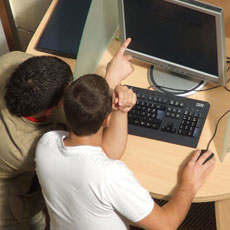When considering the major advances in communication — from the printing press, to the telephone, to the television — each medium shared the characteristic of allowing either one-to-one communication or one-to-many communication. But social media changed all that. For the first time in history “many” can speak to “many,” and this has radically changed our world.
People are just starting to understand the fundamental transformation in communication that has occurred during the past five years, and some educators don’t believe in the power that social media can bring to learning. They think of social media as students sharing personal information on Facebook. But many students are well beyond that in using social media as a combination entertainment/learning device.
One example is through the new remix culture. Not only do ordinary people create videos that are viewed by millions on YouTube, but when they become popular others soon create remixed versions that interpret it in their own way. For instance, there are scores of remixed versions of “Charlie Bit My Finger” floating around YouTube. Each revises certain elements to apply the central themes to some other area, such as work, sports, etc., thus making it their own.
 |
While fun to create, a remix also can be used as a learning activity. A group of medical students did a remix of Justin Timberlake’s “Sexy Back” that they titled “Diagnosis Wenckebach.” Wenckebach is a cardiac arrhythmia, and the resulting video has been viewed by millions. It is now being used by medical students around the world to learn about the condition.
Creating the video was a learning activity. The students who developed it had to fully understand the condition and how it is treated in order to create a coherent and accurate narrative that fits the melody, as well as elements of the original theme.
Remixing is also a fundamentally creative process, as the creator must develop links between two different topics. The process forces the creator to see the topic from new perspectives. This gets to the very heart of creativity, and even genius. Many great scientific breakthroughs were a result of connecting seemingly dissimilar elements. For instance, Einstein came up with his General Theory of Relativity when he saw workers on a roof outside of his window and imagined what would happen if one fell off.
One simple way to use remixing in your classes is to provide extra credit to students who develop a short video that reinterprets some part of popular culture in a way related to the class subject. The original can be a song, commercial, movie, etc. Students can also remix elements of photographs or text.
Consider how remixing can foster engagement, creativity, and learning in your classes.
Feedback
As usual, I welcome your comments, criticisms, and cries of outrage in the comments section of this blog.
Links
Remix examples:
- “Diagnosis Wenckeback” (Student video. A lot of fun. Trust me.)
http://www.youtube.com/watch?v=GVxJJ2DBPiQ - The Class (Parody of “The Office” for a class)
http://mediatedcultures.net/ksudigg/?p=254
Discussions:
- TEDxNYED—Lawrence Lessig (Great discussion of remix culture)
http://www.youtube.com/watch?v=FhTUzNKpfio&feature=player_embedded - The Machine is (Changing) Us: YouTube and the Politics of Authenticity (Discussion of social media and communication forms)
http://www.youtube.com/watch?v=09gR6VPVrpw - How Social Media can Create History (Discussion of the transformation brought about by social media)
http://www.ted.com/talks/clay_shirky_how_cellphones_twitter_facebook_can_make_history.html
John Orlando, PhD, is the program director for the online Master of Science in Business Continuity Management and Master of Science in Information Assurance programs at Norwich University. John develops faculty training in online education and is available for consulting at jorlando@norwich.edu.




This Post Has 8 Comments
Just wanted to show off our creative nursing students. They put this whole thing together by themselves for their own entertainment/learning experience.
http://www.youtube.com/watch?v=ysg7pD30YB0
Colleen Bishop
Assistant Professor
Coordinator, The Center for Excellence in Instruction
Piedmont Virginia Community College
Pingback: Tweets that mention Education Remix: Unlocking Creativity to Boost Learning | Faculty Focus -- Topsy.com
Colleen:
This is really good. Your students should be proud. I'll show it to the nurses in my Medical Ethics class.
John
Pingback: Teo-Education.Com » Blog Archive » Education Remix: Unlocking Creativity to Boost Learning
Pingback: Listly List - Test list #testjwu
Pingback: Remix Article/Video | srklawit
Pingback: Harnessing Remix Culture In The Classrooms | Media literacies and culture
Pingback: Sharing is caring and Remixing is creating – A journey to a better me….
Comments are closed.